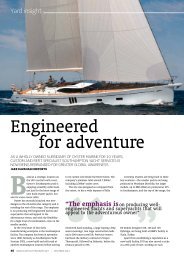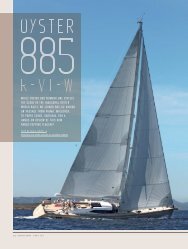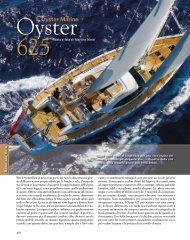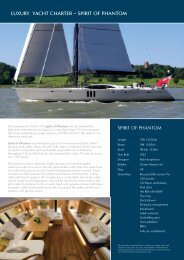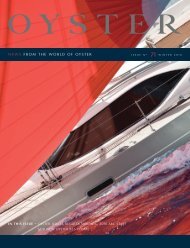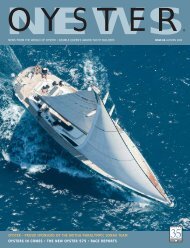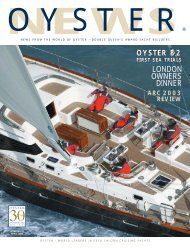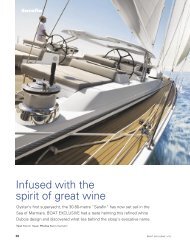Create successful ePaper yourself
Turn your PDF publications into a flip-book with our unique Google optimized e-Paper software.
SAIL TRIM<br />
Welcome to the second in<br />
our series on getting the<br />
best from your sails. In the<br />
first article we looked at<br />
headsails, the tension<br />
applied to them and the<br />
effect on your yacht's<br />
handling and performance.<br />
In this issue we are taking<br />
a closer look at mainsails.<br />
We will consider their<br />
settings and adjustments,<br />
relationship to the headsail<br />
and overall sail care.<br />
Windward sailing is where<br />
attention to detail in sail<br />
trim creates most impact.<br />
This applies particularly<br />
to mainsail trimming.<br />
To windward the main<br />
needs to be set relatively<br />
flat (compared to the<br />
headsail). Adjusting the<br />
halyard, outhaul, backstay,<br />
and to a lesser extent the<br />
battens, will have a<br />
noticeable effect on<br />
performance.<br />
26 www.oystermarine.com<br />
By Matthew Vincent of Dolphin Sails<br />
HALYARDS<br />
As with the headsail, once the main is up, the halyard tension will be the first control you need to<br />
check. The tension should be enough to just remove the horizontal wrinkles that occur in the luff.<br />
This should set the draft at the correct position, which is approximately 45-50% aft in the sail.<br />
You can check this by looking up the sail from the centre of the boom, where you can judge the<br />
draft position by the seams or draft stripes.<br />
Older sails, and in particular those made from Dacron, tend to lose their shape. As a result the<br />
draft will increase and move further aft. This means you will find it difficult to flatten the mainsail<br />
sufficiently and consequently a reduction in overall performance will occur.<br />
OUTHAUL<br />
When windward sailing in a breeze (Force 3-4+), you need to apply firm outhaul tension. Doing so<br />
will maintain a desired 5-9% draft in the lower sections of the main. More draft will increase<br />
backwind in the sail, likely to produce weather helm and a decrease in performance.<br />
BACKSTAY<br />
Increasing the tension in an adjustable backstay will straighten the forestay and flatten the<br />
headsail. Depending on your rig type, this may also have a flattening effect on the mainsail, which<br />
is desirable for windward performance.<br />
BATTENS<br />
Battens are best considered as relatively passive in your sail. A good sail is cut so that the battens<br />
will blend into the shape of your main. However, a sign that increased batten tension could<br />
improve your performance is when vertical wrinkles occur across the battens. (Note: The windward<br />
side of your main, which is in compression, will tend to look more wrinkly than the leeward side). In<br />
vertical furling mains the battens will be sewn into the sail and will not be adjustable.<br />
For off wind sailing, in order to deepen the sail and therefore generate more power in your main,<br />
a good rule of thumb is to decrease the halyard tension by approximately 0.5% of the luff length,<br />
and the outhaul by up to 1.5% of the foot length. You will also need to reduce any applied<br />
backstay tension.<br />
Once the overall shape has been set using these controls, the sheet, vang (kicker) and traveller<br />
are then used to position the sail relative to the centreline and headsail.<br />
MAINSAIL AND HEADSAIL INTERACTION<br />
A bird's eye view of a yacht (diagram) shows us that when sailing to windward, the headsail is set<br />
at a relatively wide angle from the centreline at 11-13 degrees (slightly less on performance<br />
boats), compared to the mainsail, which is set at an angle of 0-10 degrees. This indicates that the<br />
headsail provides more of the forward drive, whilst the main, which operates in a permanent<br />
header (from the headsail), is set closer to the centreline, and should be thought as more of a<br />
steering and helm balancing sail.<br />
TRAVELLER SHEET AND VANG<br />
The best way to judge if the sails are well trimmed is to feel it through the helm balance. You<br />
should be seeking to minimize rudder movement and keep it within a 0-5 degree band. For<br />
example, say you are sailing to windward in about 12 knots of breeze; the sails are well set, the<br />
main is near the centreline; the helm is nicely balanced, then a strong gust strikes your boat. She<br />
could be kept on track by applying excessive helm. However, a much better move is to ease<br />
down the traveller. Enough traveller should be eased to keep the helm within the 0-5 degree<br />
band. You will lose a little pointing ability for a moment. More importantly though you will be able<br />
to keep the helm straight, your boat on track and you will probably increase boat speed. As the<br />
gust passes, you can trim the traveller back up. Easing the traveller is preferable to easing the<br />
sheet or vang, as pointing ability is more easily maintained. A consequence of easing the traveller<br />
down may be to increase the backwind in the main. Moderate backwinding is preferable to<br />
excessive helm use.




